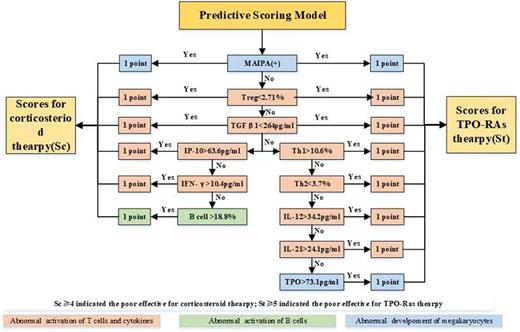Abstract
Background: Corticosteroid and TPO receptor agonists (TPO-RAs) are currently the most important and widely used drugs for the treatment of immune thrombocytopaenia (ITP). However, their efficacy varies significantly, which may be related to multifactorial mechanisms, such as dysregulated immune cells and microenvironment, abnormal MK development.For clinical drug options, finding effective predictive biomarkers and establishing a prediction evaluation system is necessary and urgent.
Method: We conducted this observational, prospective study from January 7, 2019 to April 5, 2022, we have comprehensively detected clinical indicators(age, sex, ITP phase, autoimmune markers , C3, C4, baseline platelets, TGF-β1, TPO, IP-10, IL-1α, IL-1β, IL-2, IL-4, IL-5, IL-6, IL-10, IL-12, IL-17A, IL-21, MCP-1, TNF-α, IFN-γ, CD3+T, CD4+T, CD8+T, Treg, Th1, Th2, Th17, NK, NKT, γδT, B cell, Breg, monocyte, MAIPA, MK count and stage) of ITP patients before treatment, and followed up at least 3 months with subsequent treatment. Univariate and multivariate analyses were used to identify predictive biomarkers of corticosteroid versus TPO-RAs. Spearman correlation and ROC curve were used to determine correlation coefficient and cut-off value. And the candidate biomarkers were scored to form a scoring model.
Results: We included 20 healthy subjects, 93 patients using TPO-RAs and 89 patients using corticosteroid and evaluated more than 38 clinical indicators. We found that the baseline level of TGF-β1 is positively (r=0.572) correlated with the efficacy of TPO-RAs while TPO is negatively (r=-0.443) correlated, IL-12, IL-21 were also elevated in NR patients. In contrast, IP-10 has a good correlation (r=-0.535) for predicting corticosteroid efficacy. The treg subsets in both groups have an impact on the subsequent treatment effect, but the increased B cells affecting corticosteroid while Th1 and Th2 have effects on TPO-RA treatment. MAIPA+ patients have poor response to corticosteroid and TPO-RA, but the MK number and stage have no effect. Finally, 63 people with 11 valuable indicators (TGF-β1, TPO, IP-10, IL-12, IL-21, IFN-γ, Treg, Th1, Th2, B cell, MAIPA) were used for points. The response fraction (RF) is negatively correlated with the scores in both groups (r=-0.700 in glucocorticoid group v.s. r=-0.741 in TPO-RAs group). The ROC curve found that when Sc≥4(AUC=0.825, 95%CI 0.682-0.968)patients will not effective for corticosteroid therapy;while when St≥5(AUC=0.926, 95%CI 0.857-0.995)people will not effective for TPO-RA therapy.
Conclusion: TGF-β1 and TPO are more suitable for predicting TPO-RA efficacy, while IP-10 is more suitable for predicting corticosteroid efficacy. Besides, a novel scoring system to guide drug use and prognosis prediction were established, when Sc≥4 or St≥5 indicates that the patient may not respond well to corticosteroid or TPO-RAs, respectively.
Disclosures
No relevant conflicts of interest to declare.
Author notes
Asterisk with author names denotes non-ASH members.


This feature is available to Subscribers Only
Sign In or Create an Account Close Modal